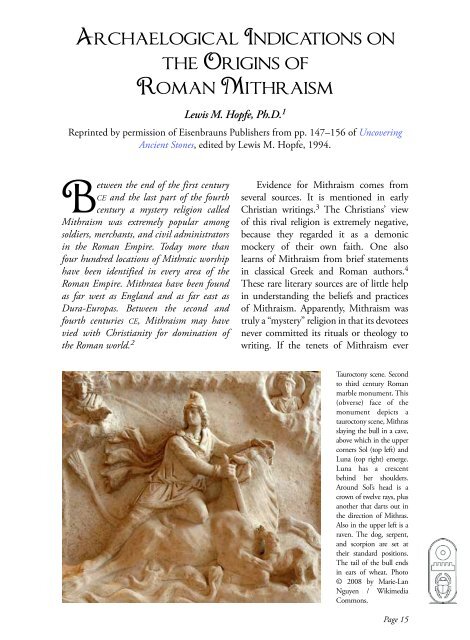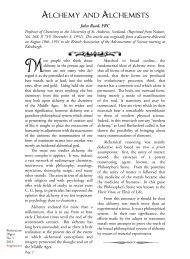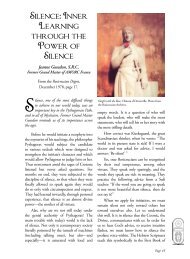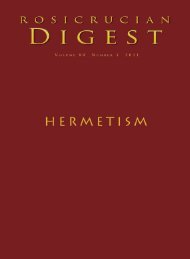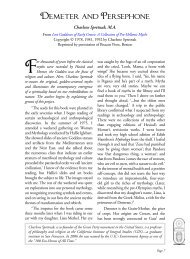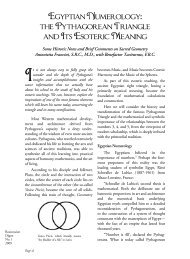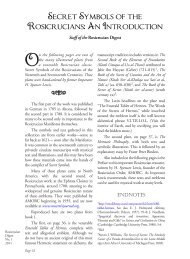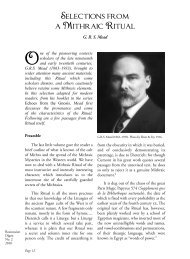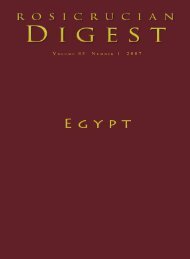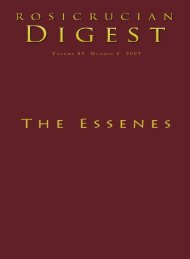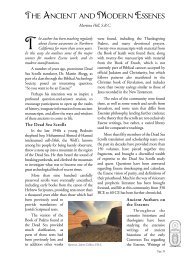Professor Lewis M. Hopfe - Kaveh Farrokh
Professor Lewis M. Hopfe - Kaveh Farrokh
Professor Lewis M. Hopfe - Kaveh Farrokh
Create successful ePaper yourself
Turn your PDF publications into a flip-book with our unique Google optimized e-Paper software.
Archaelogical Indications on<br />
the Origins of<br />
Roman Mithraism<br />
<strong>Lewis</strong> M. <strong>Hopfe</strong>, Ph.D. 1<br />
Reprinted by permission of Eisenbrauns Publishers from pp. 147–156 of Uncovering<br />
Ancient Stones, edited by <strong>Lewis</strong> M. <strong>Hopfe</strong>, 1994.<br />
Between the end of the first century<br />
ce and the last part of the fourth<br />
century a mystery religion called<br />
Mithraism was extremely popular among<br />
soldiers, merchants, and civil administrators<br />
in the Roman Empire. Today more than<br />
four hundred locations of Mithraic worship<br />
have been identified in every area of the<br />
Roman Empire. Mithraea have been found<br />
as far west as England and as far east as<br />
Dura-Europas. Between the second and<br />
fourth centuries ce, Mithraism may have<br />
vied with Christianity for domination of<br />
the Roman world. 2<br />
Evidence for Mithraism comes from<br />
several sources. It is mentioned in early<br />
Christian writings. 3 The Christians’ view<br />
of this rival religion is extremely negative,<br />
because they regarded it as a demonic<br />
mockery of their own faith. One also<br />
learns of Mithraism from brief statements<br />
in classical Greek and Roman authors. 4<br />
These rare literary sources are of little help<br />
in understanding the beliefs and practices<br />
of Mithraism. Apparently, Mithraism was<br />
truly a “mystery” religion in that its devotees<br />
never committed its rituals or theology to<br />
writing. If the tenets of Mithraism ever<br />
Tauroctony scene. Second<br />
to third century Roman<br />
marble monument. This<br />
(obverse) face of the<br />
monument depicts a<br />
tauroctony scene, Mithras<br />
slaying the bull in a cave,<br />
above which in the upper<br />
corners Sol (top left) and<br />
Luna (top right) emerge.<br />
Luna has a crescent<br />
behind her shoulders.<br />
Around Sol’s head is a<br />
crown of twelve rays, plus<br />
another that darts out in<br />
the direction of Mithras.<br />
Also in the upper left is a<br />
raven. The dog, serpent,<br />
and scorpion are set at<br />
their standard positions.<br />
The tail of the bull ends<br />
in ears of wheat. Photo<br />
© 2008 by Marie-Lan<br />
Nguyen / Wikimedia<br />
Commons.<br />
Page 15
Rosicrucian<br />
Digest<br />
No. 2<br />
2010<br />
were written down, no evidence of such<br />
writings has so far come to light.<br />
By far the greatest evidences for<br />
Mithraism are found in its many<br />
remaining places of worship. Throughout<br />
the Roman Empire Mithraists worshiped<br />
in underground rooms. The typical<br />
Mithraeum was built in a rectangular<br />
form, with benches installed along<br />
each wall. Along the back wall was the<br />
taurectone, the central image of the cult,<br />
which depicted Mithras slaying the<br />
sacred bull. An altar was often placed in<br />
front of the taurectone. The ceilings of<br />
the Mithraea were frequently painted<br />
blue, with stars representing the heavens.<br />
Sometimes the walls of these meeting<br />
places were decorated with frescoes that<br />
showed scenes from the story of Mithras<br />
or moments in the initiatory rites. Some<br />
Mithraea have adjoining side rooms for<br />
instruction or other rituals. A Mithraeum<br />
in Ostia has mosaic floors portraying<br />
symbols of the various grades of the<br />
Mithraic orders. 5 In addition, Mithraea<br />
often contain plaques of dedication<br />
revealing the names of the Mithraists<br />
who worshiped at these locations and,<br />
because they are dated, the periods during<br />
which the shrine was in use. From these<br />
paintings, statues, mosaics, and dedication<br />
plaques it is possible to draw only an<br />
outline of the religion of Mithraism.<br />
The Origins of Mithraism<br />
The question of the origin of<br />
Mithraism has intrigued scholars for many<br />
years. Franz Cumont, one of the greatest<br />
students of Mithraism, theorized that<br />
the roots of the Roman mystery religion<br />
were in ancient Iran. 6 He identified<br />
the ancient Aryan deity who appears<br />
in Persian literature as Mithra with the<br />
Hindu god Mitra of the Vedic hymns.<br />
Mithra/Mitra was a solar deity. With the<br />
coming of Zoroastrianism to Persia in the<br />
Page 16<br />
sixth century bce, Mithra was demoted<br />
to a minor rank among the angels that<br />
served the supreme Zoroastrian god<br />
Ahura Mazda. The Magi, who were<br />
Zoroastrian priests, carried the message<br />
of Mithra first to Babylon and then into<br />
Asia Minor as they established religious<br />
colonies. After the collapse of the Persian<br />
Empire in the fourth century bce and the<br />
dominance of the Hellenistic rulers, the<br />
Magi continued to worship Mithra. In<br />
the religious and philosophical ferment<br />
of Asia Minor in the first and second<br />
centuries bce, Mithraism began to take its<br />
distinctive shape. Cumont pointed to the<br />
use of the name Mithradates among the<br />
rulers of Asia Minor during that era and<br />
statuary showing them receiving power<br />
from Mithras as evidence for Mithraism’s<br />
crystallization in this place and time. He<br />
admitted that the precise location and<br />
time of the development of Mithraism is<br />
uncertain. However, by the first century<br />
ce, Cumont believed that Mithraism<br />
had developed its distinctive theology<br />
and rituals. Cumont accepted Plutarch’s<br />
statement that the pirates of Cilicia were<br />
devotees of Mithras. 7 It was believed that<br />
these pirates acquainted the Romans with<br />
Mithraism. For many years, Cumont’s<br />
theory of the origin of Mithraism was<br />
widely accepted. 8<br />
In 1971 at the First International<br />
Congress of Mithraic Studies, John<br />
Hinnells, the organizer of the Congress<br />
and editor of the two-volume collection<br />
of papers presented there, challenged<br />
Cumont’s position on the Iranian<br />
origin of Mithraism. 9 Hinnells attacked<br />
Cumont’s interpretation of the Mithraic<br />
symbols and his identification of them<br />
with elements in Iranian religion. At<br />
the same conference, R. L. Gordon also<br />
attacked the theory of Iranian origin. 10<br />
Both scholars accused Cumont of
Tauroctony scene bas-relief found in Aquilea. Collection of the Kunsthistorisches Museum, Vienna. Photo © 2010 by<br />
CristianChirita / Wikimedia Commons.<br />
circular thinking. According to Hinnells<br />
and Gordon, Cumont believed that<br />
Roman Mithraism developed from<br />
Iranian religion, found Iranian parallels<br />
to the symbols of Mithraism, and then<br />
used these parallels to prove the Iranian<br />
foundations for Mithraism.<br />
Even though Hinnells and Gordon<br />
effectively destroyed Cumont’s theory,<br />
neither offered an alternative hypothesis.<br />
Hinnells believed that Mithraism still had<br />
a basic Iranian origin, though his belief<br />
was not based upon Cumont’s theories.<br />
Gordon frankly admitted ignorance of the<br />
true source of Mithraism and postulated<br />
that no one will ever know its origins.<br />
Recently, another theory of the origin<br />
of Mithraism has been set forth by David<br />
Ulansey. 11 Ulansey theorizes that Mithraism<br />
arose in the city of Tarsus in Asia Minor.<br />
He believes it was devised and propagated<br />
by a group of Stoic philosophers who<br />
thought they had discovered astronomical<br />
evidence to prove the existence of a new<br />
and powerful god. They identified this<br />
god with Perseus, one of the hero gods of<br />
Tarsus. Since the constellation of Perseus<br />
was directly above the constellation of<br />
Tarsus the bull, the philosophers believed<br />
that Perseus dominated the bull. This new<br />
religion became popular with the Cilician<br />
pirates who had close ties to the intellectual<br />
circles of Tarsus and who were interested<br />
in astral religion. They changed the name<br />
of the hero god from Perseus to Mithra in<br />
honor of Mithridates vi Eupator, the last<br />
of the dynasty of rulers of Pontus before<br />
Roman rule. It was this group of piratesailors<br />
who gave Mithraism its form and<br />
spread the religion to the Roman world.<br />
Page 17
Rosicrucian<br />
Digest<br />
No. 2<br />
2010<br />
All theories of the origin of Mithraism<br />
acknowledge a connection, however<br />
vague, to the Mithra/Mitra figure of<br />
ancient Aryan religion. They all point to<br />
Persian influence in Asia Minor during the<br />
Hellenistic era and to the religious ferment<br />
of that period. All see the city of Tarsus<br />
as a starting point of Roman Mithraism.<br />
Plutarch’s single statement about the<br />
Cilician pirates carries enormous weight,<br />
and as a result, all theorists accept them<br />
as the missionaries who carried the new<br />
religion to Rome.<br />
The theories of the origin of Mithraism<br />
from Cumont to Ulansey remain only<br />
theories. Because of a dearth of literary<br />
evidence, we cannot be certain that<br />
Mithraism developed in a certain place<br />
or a certain time. However, the weight of<br />
scholarly opinion has clearly moved away<br />
from the long-held theory that Mithraism<br />
began in Persia and moved westward<br />
across Babylon, Syria, Asia Minor, and<br />
into Rome.<br />
Archaeological evidence is the<br />
strongest source of information about<br />
Mithraism. The remains of hundreds of<br />
Mithraic worship sites, the sculpting and<br />
painting of those sites, and the dedicatory<br />
plaques reveal a religion widespread across<br />
the Roman Empire from the second<br />
through the fourth centuries ce. Current<br />
archaeological evidence may bear out the<br />
critics of Cumont’s theory of the origin<br />
of Mithraism. If, as Cumont believed,<br />
Mithraism began as an Iranian cult and<br />
then moved west into Syria and on to<br />
Rome, one might expect to find wellestablished<br />
cult centers in Roman Syria.<br />
An examination of a map showing the<br />
locations of Mithraic centers in the<br />
Roman empire reveals that this is not<br />
so. While Mithraic materials have been<br />
found throughout the empire, the heaviest<br />
concentration is located in central Italy<br />
Page 18<br />
and northern Germany. East and west<br />
of these centers, archaeological evidence<br />
grows thinner. In Asia Minor Mithraic<br />
sites are relatively rare. They are even<br />
scarcer in Roman Syria. At the present<br />
only three Mithraea and a scattering of<br />
Mithraic artifacts have been located in<br />
Roman Syria.<br />
The Mithraea of Roman Syria<br />
Within the geographical dimensions<br />
of Roman Syria only three Mithraea have<br />
been discovered and excavated. They are<br />
located at Dura-Europas on the far eastern<br />
border of Roman Syria, at Sidon on the<br />
Mediterranean coast of Phoenicia, and at<br />
Caesarea Maritima on the Mediterranean<br />
coast of Roman Palestine. 12<br />
Dura-Europas is located on the<br />
extreme eastern border of Roman Syria on<br />
the banks of the Euphrates River. The city<br />
was established by Seleucid rulers about<br />
300 bce to protect trade routes. Roman<br />
occupation of the city began in 164 ce<br />
and continued until 256, when it was<br />
conquered by the Sassanians.<br />
During the ninety years of Roman<br />
occupation, Dura-Europas was apparently<br />
inhabited by diverse religious populations.<br />
Archaeological excavations carried on in<br />
the 1920s and 1930s revealed a Christian<br />
chapel, a Jewish synagogue and a<br />
Mithraeum. The results of these excavations<br />
were thoroughly published, 13 and as a<br />
result, students of Syrian Mithraism know<br />
more about the Dura-Europas Mithraeum<br />
than any other site.<br />
The Dura-Europas Mithraeum was<br />
apparently begun in the late second century<br />
ce. Its first phase was probably a small<br />
room in a private home. Unlike other<br />
Mithraea, which were built underground<br />
to simulate Mithras’s actions in the sacred<br />
cave, the Dura-Europas Mithraeum was
above ground. Certain details were added to<br />
make it appear to be a cave. The furniture<br />
and arrangement of this Mithraeum are<br />
fairly typical of the period. It contained two<br />
carved reliefs of Mithras killing the sacred<br />
bull (taurectone), benches ran the length<br />
of the room, there were two altars, and<br />
the Mithraeum contained two dedicatory<br />
plaques naming Roman military leaders<br />
among its patrons.<br />
In the early third century ce, the<br />
Dura-Europas Mithraeum was apparently<br />
destroyed and rebuilt. The second phase<br />
was larger and more elaborate than the<br />
first. Dedications in this phase reveal that<br />
the rebuilding was done during the reign<br />
of Septimius Severus. The revised and<br />
enlarged Mithraeum probably<br />
indicates a larger Mithraic<br />
community in this outpost city.<br />
This phase is distinguished by<br />
a series of drawings illustrating<br />
aspects of the life of Mithras<br />
and the life of the worshiping<br />
community. Some aspects of<br />
these drawings are truly unique<br />
in Mithraism. 14<br />
In the middle third century,<br />
the Dura-Europas Mithraeum<br />
was again enlarged. The altar<br />
area was raised, additional rooms<br />
were built, and new paintings<br />
were added. This may indicate<br />
further growth in the popularity<br />
of the religion in this region.<br />
Dura-Europas was conquered<br />
by the Sassanians in 256 ce,<br />
driving the Roman army and<br />
influence from this eastern<br />
frontier of the empire. The<br />
Mithraeum was destroyed, and<br />
Mithraic worship apparently<br />
came to an end. The Sassanians,<br />
who were Zoroastrian, had no<br />
use for a Roman Mithraeum.<br />
A second center of Mithraic worship<br />
that has been excavated in Roman Syria is<br />
found in the ancient city of Sidon. Sidon<br />
was located on the Mediterranean coast<br />
of Roman Syria approximately halfway<br />
between Tyre on the south and Berytus<br />
(modern Beirut) on the north.<br />
A Mithraeum was excavated in Sidon in<br />
the late nineteenth century. The results of<br />
the excavation of this site were reported by<br />
the journalist E. Durighello and repeated<br />
by S. Reinach. 15 Generally, students of<br />
Mithraism are dissatisfied with these<br />
reports, feeling that they are incomplete. 16<br />
After the completion of the excavation, the<br />
site was covered and no further excavation<br />
was possible. Today all that remains of<br />
Tauroctony Scene, second century ce. Fresco and bas-relief from the<br />
Mithraeum at Dura-Europas.<br />
Page 19
Dedicatory Stele to Mithras by Ulbius Gaianus, a civil servant of the postal service (praefectus vehiculorum). Second century<br />
ce. Collection of the Archaeological Museum in Milan. Photo © 2008 by Giovanni Dall’Orto / Wikimedia Commons.<br />
Rosicrucian<br />
Digest<br />
No. 2<br />
2010<br />
the Sidon Mithraeum are eleven pieces of<br />
sculpture now housed in the Louvre.<br />
With only limited archaeological<br />
materials available it has been difficult to<br />
assign a date to the Sidon Mithraeum.<br />
Several dedicatory plaques from the<br />
building give the name of Fl. Gerontios<br />
and the year 500. If normal standards of<br />
Roman Syrian chronology are applied,<br />
the date of the building of the Mithraeum<br />
would have been approximately 188 ce.<br />
Ernest Will disputes this chronology and<br />
places the dedication in the late fourth<br />
century ce. 17 The earlier date for the<br />
building of this Mithraeum would be more<br />
in keeping with the Mithraea at Dura-<br />
Europas and Caesarea Maritima.<br />
The extant pieces of sculpture from the<br />
Sidon Mithraeum include a bas-relief of<br />
the taurectone, including the twelve signs<br />
of the zodiac; a statue of the taurectone;<br />
a statue of Mithras carrying a sacred bull;<br />
Page 20<br />
a statue of a winged, lion-headed figure<br />
with a set of keys; four statues of the<br />
companions of Mithras, usually identified<br />
as Cautes and Cautopates; a statue of the<br />
triple-headed earth goddess, Hekate; and<br />
two statues of Venus.<br />
The most recently discovered Mithraeum<br />
in Roman Syria was found during the<br />
excavation of Caesarea Maritima in 1973. 18<br />
Caesarea Maritima is located on the<br />
Mediterranean coast of Roman Palestine. 19<br />
The city was built on an essentially virgin<br />
location between 22 and 10 bce by Herod<br />
the Great. 20 It was named for and dedicated<br />
to his sponsor, Augustus Caesar. Among<br />
the many unique features of this city was a<br />
huge artificial harbor. Since Palestine had<br />
so few natural ports on the Mediterranean<br />
coastline, Caesarea Maritima became the<br />
natural location for the disembarkation of<br />
Roman troops and administrators during<br />
the troubled first and second centuries ce.
Soon after its dedication Caesarea Maritima<br />
became the political capital of Palestine. It<br />
remained one of the leading cities of Syria<br />
until long after its conquest by the Muslims<br />
in 640 ce.<br />
Because of its location and massive<br />
remains, Caesarea Maritima has long been<br />
the site of archaeological activity. During<br />
the 1973 season, the joint Expedition<br />
to Caesarea uncovered an underground<br />
vaulted room in the sand dunes just off<br />
the Mediterranean coast. Although this<br />
large room lacked the massive statuary<br />
and dramatic paintings that are frequently<br />
associated with Mithraea, and although<br />
there are no known literary references<br />
to Mithraism at Caesarea Maritima,<br />
sufficient evidence was found to identify<br />
it as a site of Mithraic worship. At the<br />
present, this is the only Mithraeum<br />
known in Roman Palestine.<br />
Excavation of the room revealed the<br />
typical participants’ benches running<br />
along either side. At the east end of the<br />
vault was a small, almost square stone,<br />
which was identified as the base for an<br />
altar. Beside the altar stone was found<br />
a collection of Roman-era lamps and a<br />
small, circular, engraved marble piece.<br />
This medallion was inscribed with the<br />
taurectone image and three small scenes<br />
from the life of Mithras. On the walls<br />
of the vault were the faint remains of<br />
frescoes that may have depicted scenes<br />
from initiatory rituals. The ceiling showed<br />
slight traces of blue paint. During its days<br />
as an active Mithraeum, the entire ceiling<br />
may have been painted to represent the<br />
sky and the stars. 21<br />
It is difficult to assign an exact date<br />
to the founding and life of the Caesarea<br />
Maritima Mithraeum. No dedicatory<br />
plaques have been discovered that might<br />
aid in the dating. The lamps found with the<br />
taurectone medallion are from the end of<br />
the first to the late third century ce. Other<br />
pottery and coins from the vault are also<br />
from this era. Therefore, it is speculated that<br />
this Mithraeum was developed toward the<br />
end of the first century and remained active<br />
until the late third century. 22 This matches<br />
the dates assigned to the Dura-Europas and<br />
the Sidon Mithraea.<br />
Mithras and the Bull, second century fresco from the Temple of Mithras,<br />
Marino, Italy.<br />
Mithraic Articles from Roman<br />
Syria<br />
In addition to the fully<br />
developed Mithraea of Dura-<br />
Europas, Sidon, and Caesarea<br />
Maritima, a few articles of<br />
Mithraic worship have been<br />
discovered in the area of Roman<br />
Syria.<br />
A rectangular relief of<br />
the taurectone was found in<br />
northeastern Syria at Arsha-wa-<br />
Qibar in 1932. 23 Though the<br />
engraving of the relief is not<br />
clear, most of the elements of<br />
the taurectone can be identified.<br />
These include the bull, Mithras,<br />
Page 21
Rosicrucian<br />
Digest<br />
No. 2<br />
2010<br />
Asclepius, god of medicine. Second century ce Roman copy<br />
of a Greek original of the early fourth century bce, restored<br />
in the eighteenth century. Photo © 2006 by Marie-Lan<br />
Nguyen / Wikimedia Commons.<br />
the snake, the dog, the raven, Sol and<br />
Luna, and Cautes and Cautopates. The<br />
relief contains no inscription, and it is<br />
impossible to assign a date or to connect it<br />
to a Mithraeum.<br />
Sahin, located in northern Syria, has<br />
yielded a Greek inscription that seems to<br />
be a dedicatory plaque to Mithras. Some<br />
letters on this plaque are missing, and its<br />
Page 22<br />
meaning is not absolutely clear. However,<br />
the best guess connects it to the worship of<br />
Mithras. 24 It appears to have been written in<br />
the early third century ce.<br />
Two Mithraic reliefs were found in<br />
the ruins of the temple of Dusares at Secia<br />
located southwest of Sidon. 25 Both of<br />
these rectangular reliefs are carved from<br />
basalt and appear to be the work of the<br />
same sculptor. Both show the taurectone<br />
scene with all its figures. In the first only<br />
Cautes is present, 26 while in the second<br />
both Cautes and Cautopates are visible.<br />
Cumont suggested that at some point<br />
Mithras had become identified with<br />
Dusares, “the Arab Dionysus” 27 and<br />
speculates that the temple of Dusares<br />
contained these taurectone reliefs.<br />
The Aleppo museum contains a relief<br />
showing the head of Mithras. The exact<br />
source of this relief is not known, but it was<br />
probably found on the Mediterranean coast<br />
between Lattakieh and Tartous. Though<br />
the relief is badly worn, it shows the head<br />
of Mithras with its typical curls, Phrygian<br />
cap, and nimbus. This head may have<br />
been carved in the first half of the second<br />
century ce. 28<br />
A cippus found at Sidon bears an<br />
inscription in Greek that is a dedication<br />
to the god Asclepius by Theodotos,<br />
hiereus of Mithras. 29 The cippus may<br />
have been a gravestone. This inscription<br />
is dated 140–141 ce and is therefore the<br />
earliest reference to Mithras from Roman<br />
times in Syria.<br />
A knife found at Niha in central<br />
Lebanon was apparently connected to<br />
Mithraism. 30 Its handle is elaborately<br />
carved and includes the head of a bull. It<br />
also contains the heads of a lion, a bear,<br />
a snake, a scorpion, as well as a krater,<br />
a Phrygian cap, and two busts. Because<br />
several of these items are a part of the
taurectone, it is believed that this knife<br />
may have been connected to Mithraism in<br />
this region. The knife bears no indication<br />
of date or place of origin.<br />
In the late nineteenth century, the<br />
British Museum received a small bronze<br />
lion-headed figure from Beirut. The object<br />
is approximately three inches long and has<br />
a human body and wings. There is some<br />
indication that once there may have been<br />
a snake attached to the body. Even though<br />
the object was not found with other<br />
Mithraic materials, it is assumed to be<br />
an image of Kronos. 31 Barnett speculates<br />
that the figure may have belonged to the<br />
Sidon Mithraeum. 32<br />
Conclusion<br />
In the brief survey presented in this<br />
paper it is clear that the number and<br />
quality of Mithraic materials uncovered<br />
in Roman Syria is extremely limited. Only<br />
three Mithraea have been excavated in the<br />
region. The Dura-Europas Mithraeum<br />
on the eastern frontier of the empire was<br />
apparently a full temple, the equal of<br />
any. It has been fully excavated and fully<br />
reported. The Sidon Mithraeum remains<br />
something of a mystery because of the<br />
incomplete reports of its excavation.<br />
The Caesarea Maritima Mithraeum was<br />
apparently poor in its furnishings and<br />
relatively small. In addition, time and the<br />
atmosphere have deteriorated many of<br />
the frescoes that might have told a more<br />
complete story at this site. Beyond these<br />
three Mithraea, there are only a handful of<br />
objects from Syria that may be identified<br />
with Mithraism.<br />
Archaeological evidence of Mithraism<br />
in Syria is therefore in marked contrast to<br />
the abundance of Mithraea and materials<br />
that have been located in the rest of the<br />
Roman Empire. Both the frequency<br />
and the quality of Mithraic materials are<br />
Mithraic Kronos or Zervan Arkana, deity of endless time<br />
in Zoroastrian religion. Dedicated 190 CE by C. Valerius<br />
Heracles and his sons. Mithraeum of Ostia. Image in Franz<br />
Cumont, The Mysteries of Mithra (1902).<br />
greater in the rest of the empire. Even on<br />
the western frontier in Britain, archaeology<br />
has produced rich Mithraic materials, such<br />
as those found at Walbrook.<br />
If one accepts Cumont’s theory<br />
that Mithraism began in Iran, moved<br />
west through Babylon to Asia Minor,<br />
and then to Rome, one would expect<br />
that the religion left its traces in those<br />
locations. Instead, archaeology indicates<br />
that Roman Mithraism had its epicenter<br />
in Rome. Wherever its ultimate place of<br />
origin may have been, the fully developed<br />
religion known as Mithraism seems to<br />
Page 23
Rosicrucian<br />
Digest<br />
No. 2<br />
2010<br />
have begun in Rome and been carried to<br />
Syria by soldiers and merchants. None<br />
of the Mithraic materials or temples in<br />
Roman Syria except the Commagene<br />
sculpture bears any date earlier than the<br />
late first or early second century. 33 While<br />
little can be proved from silence, it seems<br />
that the relative lack of archaeological<br />
evidence from Roman Syria would argue<br />
against the traditional theories for the<br />
origins of Mithraism.<br />
Page 24<br />
ENDNOTES<br />
1<br />
The publisher thanks Prof. Gary Lease, who read<br />
the proofs of Dr. <strong>Hopfe</strong>’s article.<br />
2<br />
The French historian Ernest Renan stated that if<br />
Christianity had not developed, the world would<br />
have become Mithraic. Ernest Renan, Marc-Aurele<br />
et la fin du monde antique (Paris: Calmann–Levy,<br />
1923), 579.<br />
3<br />
See Tertullian, De praescriptione haereticorum, 40<br />
and Jerome, Epistle 107 Ad Laetam.<br />
4<br />
The Emperor Julian made brief reference to his<br />
devotion to Mithras (Helios) in Oration 4, Hymn<br />
to King Helios Dedicated to Sallust.<br />
5<br />
Samuel Leuchili, ed., Mithraism in Ostia (Evanston:<br />
Northwestern University Press, 1967).<br />
6<br />
Franz Cumont, Textes et Monuments Figures<br />
Relatifs aux Mystères de Mithra (Brussels: H.<br />
Lamertin, 1896–99).<br />
7<br />
Plutarch, Life of Pompey 24:5.<br />
8<br />
Essentially the same theory of the origin and<br />
development of Mithraism is expressed by A.<br />
D. Nock, Conversion (1933; reprinted Lanham,<br />
Maryland: University Press of America, 1988), 41ff.<br />
9<br />
John Hinnells, “Reflections on the Bull-Slaying<br />
Scene,” Mithraic Studies (ed. John Hinnells)<br />
(Manchester: Manchester University Press, 1975),<br />
Vol 2, 290–313.<br />
10<br />
R. L. Gordon, “Franz Cumont and the Doctrines<br />
of Mithraism,” Mithraic Studies (ed. John Hinnells;<br />
Manchester: Manchester University Press, 1975),<br />
vol. 1, 215–48.<br />
11<br />
David Ulansey, The Origins of the Mithraic<br />
Mysteries: Cosmology and Salvation in the Ancient<br />
World (New York: Oxford University Press,<br />
1989).<br />
12<br />
For a more complete description of the Mithraea<br />
and the Mithraic materials discussed here, see<br />
L. M. <strong>Hopfe</strong>, “Mithraism in Syria,” Aufstieg und<br />
Niedergang der Romischen Welt part 2/18/4, 2214–<br />
35.<br />
13<br />
M. I. Rostovtzeff, Das Mithraeum von Dura<br />
(Regensburg: Mitteilungen des Deutschen<br />
Archaologischen Instituts, Romische Abteilung<br />
49, 1934), 180–207; M. I. Rostovtzeff, et al., The<br />
Excavations at Dura-Europos: Preliminary Report<br />
of the Seventh and Eighth Seasons of Work (New<br />
Haven: Yale University Press, 1939).<br />
14<br />
For a more complete discussion of these<br />
drawings, see Franz Cumont, “The Dura<br />
Mithraeum,” Mithraic Studies (ed. John Hinnells)<br />
(Manchester: Manchester University Press, 1975),<br />
vol 1, 151–214.<br />
15<br />
E. Durighello, [no title], originally published in Le<br />
Bosphore Egyptien, August 19 1887; reprinted in Revue<br />
Archeologique (1888) part 1, 91–93; and subsequently<br />
reprinted with a brief critical introduction in Salomon<br />
Reinach, “Sidon,” Chroniques d’Orient 1 (Paris:<br />
Didot, 1891), 434–46.<br />
16<br />
M. J. Vermaseren, Corpus Inscriptionum et<br />
Monumentorum Religionis Mithraicae (CIMRM). 2<br />
volumes (The Hague: Martinus Nijhoff, 1956–60)<br />
1.73; Israel Roll, “The Mysteries of Mithras in the<br />
Roman Orient: The Problem of Origin,” Journal of<br />
Mithraic Studies 2 (1977), note 8.<br />
17<br />
Ernest Will, “La date du Mithraeum de Sidon,”<br />
Syria 27 (1950): 261–69.<br />
18<br />
See L. M. <strong>Hopfe</strong> and G. Lease, “The Caesarea<br />
Mithraeum: A Preliminary Announcement,”<br />
Biblical Archaeologist 38(1) (1975): 2–10; R.<br />
Bull, “A Mithraic Medallion from Caesarea,” Israel<br />
Exploration Journal 24 (1974): 187–90; J. A.<br />
Blakely, The Joint Expedition to Caesarea Maritima,<br />
Excavation Reports: The Pottery and Dating of Vault<br />
1: Horreum, Mithraeum, and Later Uses (<strong>Lewis</strong>ton,<br />
New York: Edwin Mellen, 1987).
19<br />
This city is known as “Caesarea Maritima” to<br />
distinguish it from the other Caesarean of Roman Syria.<br />
20<br />
The construction and magnificent features of<br />
Caesarea Maritima are described by Josephus (see<br />
Antiquities 15.9.6).<br />
21<br />
For a more complete description of the<br />
furnishings of the Caesarea Maritima Mithraeum,<br />
see <strong>Hopfe</strong> and Lease, “Caesarea Mithraeum,” and<br />
Bull, “A Mithraic Medallion from Caesarea.”<br />
22<br />
For the most detailed development of the<br />
Caesarea Maritima Mithraeum, see Blakely, Joint<br />
Expedition, 150.<br />
23<br />
Vermaseren, Corpus Inscriptionum et<br />
Monumentorum Religionis Mithraicae (CIMRM),<br />
Mon. 71, cf. Plate 5; cf. note 15 above.<br />
24<br />
The Mithraic reading of this inscription has<br />
been challenged by R. Mouterde, Melanges de<br />
l’Universite Saint Joseph 31 (1954): 334.<br />
25<br />
Ernest Will, “Nouveaux Monuments Sacres de<br />
la Syrie Romaine,” Syria 29 (1952): 67–93.<br />
26<br />
Vermaseren, Corpus Inscriptionum et Monumentorum<br />
Religionis Mithraicae (CIMRM), Mon. 88.<br />
27<br />
F. Cumont, “The Dura Mithraeum,” in Mithraic<br />
Studies (ed. John R. Hinnells) (Manchester:<br />
Manchester University Press, 1975), vol 1, 160.<br />
28<br />
See Will, “Nouveaux Monuments,” 67.<br />
29<br />
M. Dunand, “Le Temple d’Echmoun a Sidon,”<br />
Bulletin du Musee de Beyrouth 26 (1973): 27–44.<br />
30<br />
H. Seyrig, “Un Couteau de Sacrifice,” Iraq 36<br />
(1974): 229–30.<br />
31<br />
R. D. Barnett, “A Mithraic Figure from<br />
Beirut,” Mithraic Studies (ed. John R. Hinnells)<br />
(Manchester: Manchester University Press, 1975),<br />
466–69.<br />
32<br />
Ibid., 466.<br />
33<br />
Mithras, identified with a Phrygian cap<br />
and the nimbus about his head, is depicted in<br />
colossal statuary erected by King Antiochus I<br />
of Commagene, 69–34 bce (see Vermaseren,<br />
CIMRM 1.53–56). However, there are no other<br />
literary or archaeological evidences to indicate that<br />
the cult of Mithras as it was known among the<br />
Romans in the second to fourth centuries ce was<br />
practiced in Commagene.<br />
Mithraism was truly a<br />
“mystery” religion in that its<br />
devotees never committed its<br />
rituals or theology to writing.<br />
If the tenets of Mithraism<br />
ever were written down, no<br />
evidence of such writings<br />
has so far come to light. By<br />
far the greatest evidences for<br />
Mithraism are found in its<br />
many remaining places of<br />
worship. Throughout the<br />
Roman Empire Mithraists<br />
worshiped in underground<br />
rooms. The typical Mithraeum<br />
was built in a rectangular form,<br />
with benches installed along<br />
each wall. Along the back wall<br />
was the taurectone, the central<br />
image of the cult, which<br />
depicted Mithras slaying the<br />
sacred bull.<br />
Page 25


